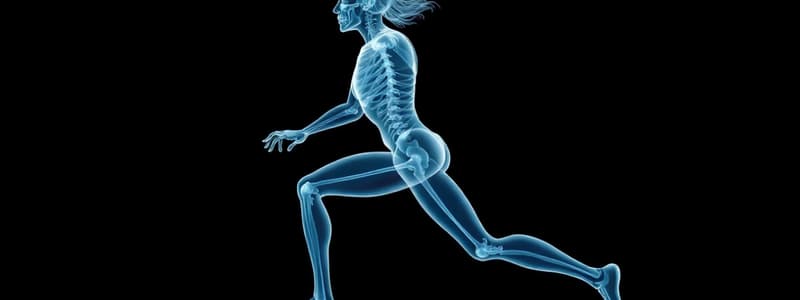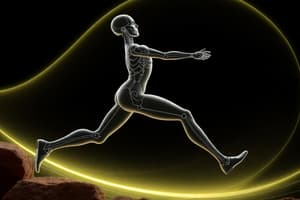Podcast
Questions and Answers
What is the impact of using a cane in the contralateral hand on muscle force?
What is the impact of using a cane in the contralateral hand on muscle force?
- It makes the cane ineffective in reducing muscle force.
- It has no effect on muscle force.
- It decreases the force required from the gluteus muscles. (correct)
- It increases the force required from the gluteus muscles.
What is the governing equation of motion when holding the cane in the contralateral hand?
What is the governing equation of motion when holding the cane in the contralateral hand?
- 0 = FJ + FW - FM
- 0 = FM + FW - FJ
- 0 = FC - FW - FM
- 0 = Fd + FJ - FC (correct)
What is the significance of the torque being zero when the cane is held in both hands?
What is the significance of the torque being zero when the cane is held in both hands?
- It indicates that forces are balanced around the axis of rotation. (correct)
- It means that the cane is ineffective for support.
- It demonstrates that the user’s muscles are engaged.
- It suggests that the user is not putting any weight on the cane.
Which force acts on the system when the cane is held in the contralateral hand?
Which force acts on the system when the cane is held in the contralateral hand?
Which of the following statements is true regarding the use of the cane?
Which of the following statements is true regarding the use of the cane?
When considering joint reaction forces, what is represented in the free body diagram?
When considering joint reaction forces, what is represented in the free body diagram?
Why is the decision to use the cane in the contralateral hand recommended?
Why is the decision to use the cane in the contralateral hand recommended?
In a free body diagram, what does the notation 'Σ = 0' signify?
In a free body diagram, what does the notation 'Σ = 0' signify?
When holding a cane in the ipsilateral hand, which equation correctly reflects the forces acting on the system?
When holding a cane in the ipsilateral hand, which equation correctly reflects the forces acting on the system?
How does drawing the internal and external forces help in analyzing the cane's effectiveness?
How does drawing the internal and external forces help in analyzing the cane's effectiveness?
In managing hip joint reaction force while carrying a heavy bag, which side should the patient carry the bag to decrease pain?
In managing hip joint reaction force while carrying a heavy bag, which side should the patient carry the bag to decrease pain?
What is the effect of carrying a bag on the contralateral side with respect to the hip joint reaction force?
What is the effect of carrying a bag on the contralateral side with respect to the hip joint reaction force?
Why is it recommended to carry a heavy bag on the contralateral side?
Why is it recommended to carry a heavy bag on the contralateral side?
What does zero torque imply when the bag is carried on the contralateral side?
What does zero torque imply when the bag is carried on the contralateral side?
When calculating the forces acting on the variables in the free body diagram, what must the sum of the torques equal when in equilibrium?
When calculating the forces acting on the variables in the free body diagram, what must the sum of the torques equal when in equilibrium?
Which muscles are primarily engaged when carrying a heavy bag on the contralateral side to reduce hip joint reaction force?
Which muscles are primarily engaged when carrying a heavy bag on the contralateral side to reduce hip joint reaction force?
What is the primary goal of managing joint reaction forces while the patient carries a heavy bag?
What is the primary goal of managing joint reaction forces while the patient carries a heavy bag?
In biomechanical terms, what happens to the joint reaction force when the bag is carried on the ipsilateral side?
In biomechanical terms, what happens to the joint reaction force when the bag is carried on the ipsilateral side?
Flashcards
Torque
Torque
The force that causes an object to rotate around an axis.
Joint Reaction Force
Joint Reaction Force
The force that acts on a joint, resulting from the combined forces of muscles, gravity, and external loads.
Ipsilateral
Ipsilateral
The side of the body on the same side as the affected limb.
Contralateral
Contralateral
Signup and view all the flashcards
Moment Arm
Moment Arm
Signup and view all the flashcards
Net Torque
Net Torque
Signup and view all the flashcards
Muscle Torque
Muscle Torque
Signup and view all the flashcards
External Torque
External Torque
Signup and view all the flashcards
Free Body Diagram
Free Body Diagram
Signup and view all the flashcards
Free Body Diagram - Clinical Case: Cane
Free Body Diagram - Clinical Case: Cane
Signup and view all the flashcards
Contralateral hand
Contralateral hand
Signup and view all the flashcards
Ipsilateral hand
Ipsilateral hand
Signup and view all the flashcards
Muscle force (FM)
Muscle force (FM)
Signup and view all the flashcards
Weight force (FW)
Weight force (FW)
Signup and view all the flashcards
Cane force (FC)
Cane force (FC)
Signup and view all the flashcards
Downward Weight force (DW)
Downward Weight force (DW)
Signup and view all the flashcards
Downward muscle force (DM)
Downward muscle force (DM)
Signup and view all the flashcards
Downward cane force (DC)
Downward cane force (DC)
Signup and view all the flashcards
Study Notes
Movement Science 1: Session II - Newton's Laws
- Clinical Case: Cane
- Patients use canes to reduce force on gluteus muscles
- Canes are held in the contralateral hand to minimize hip forces
- Using a free body diagram, isolate the body part of interest
- Define a coordinate system for the analysis
- Draw and label all external and internal forces acting on the system
- Draw the joint reaction force
- Calculate torques to determine the governing equations of motion.
- Contralateral cane use minimizes muscle force, since the cane creates torque in the same direction as the muscle.
Movement Science 1: Session II - Newton's Laws - Clinical Case: Bag
- Clinical Case: Bag
- Patients carry bags to decrease hip joint reaction forces to limit pain
- Bags are held in the contralateral side to minimize hip forces
- The contralateral hand minimizes the muscle force needed.
- Contralateral bag placement creates a reduced reaction force at the hip joint.
- This is because the torque created by the bag is in the same direction as the muscles supporting the hip.
Studying That Suits You
Use AI to generate personalized quizzes and flashcards to suit your learning preferences.




